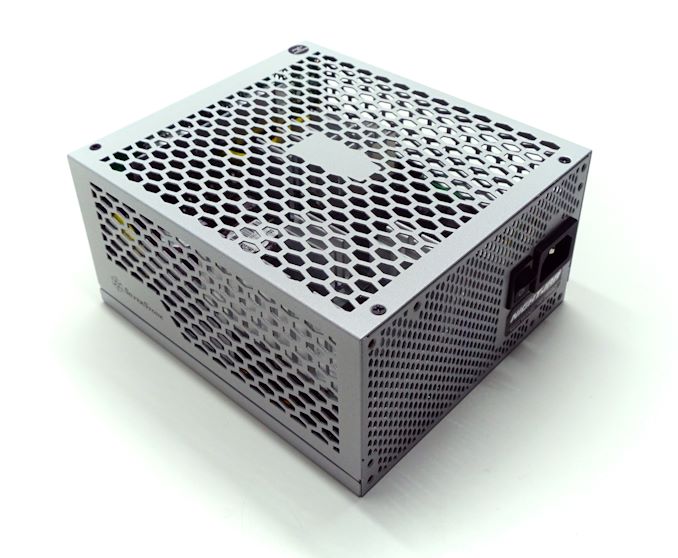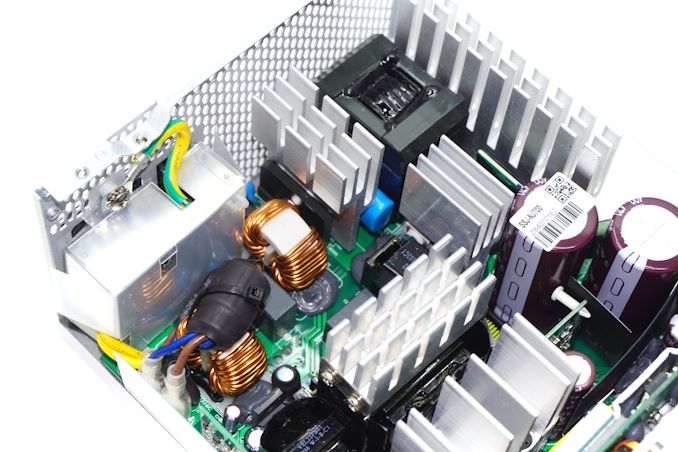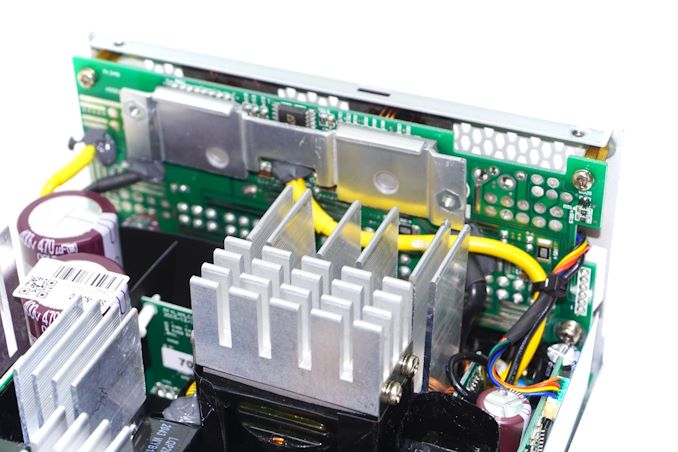The SilverStone NightJar NJ700 Passive PSU Review: Silent Excellence
by E. Fylladitakis on November 29, 2021 8:00 AM EST- Posted in
- Cases/Cooling/PSUs
- PSUs
- SilverStone
- Passive Cooling
Power Supply Quality
As part of our testing, we also check output parameters are within specifications, as well as voltage ripple and line noise.
| Main Output | ||||||||
| Load (Watts) | 141.38 W | 352.97 W | 528.19 W | 703.06 W | ||||
| Load (Percent) | 20.2% | 50.42% | 75.46% | 100.44% | ||||
| Amperes | Volts | Amperes | Volts | Amperes | Volts | Amperes | Volts | |
| 3.3 V | 1.8 | 3.41 | 4.49 | 3.41 | 6.74 | 3.4 | 8.99 | 3.39 |
| 5 V | 1.8 | 5.09 | 4.49 | 5.09 | 6.74 | 5.08 | 8.99 | 5.07 |
| 12 V | 10.42 | 12.1 | 26.06 | 12.08 | 39.09 | 12.05 | 52.12 | 12.03 |
| Line | Regulation (20% to 100% load) |
Voltage Ripple (mV) | |||||
| 20% Load | 50% Load | 75% Load | 100% Load | CL1 12V |
CL2 3.3V + 5V |
||
| 3.3V | 0.75% | 12 | 12 | 14 | 16 | 14 | 12 |
| 5V | 0.5% | 8 | 8 | 10 | 16 | 8 | 12 |
| 12V | 0.6% | 6 | 8 | 8 | 12 | 8 | 12 |
The power quality figures that we received while testing the SilverStone NJ700 inside our hotbox were astounding. We recorded a maximum voltage ripple of 12 mV on the 12V line at 100% load, an incredible power quality figure by any comparison. Voltage regulation also is very tight on the 12V line, staying lower than 0.6% across the nominal output range. The secondary 3.3V and 5V rails are a bit less well filtered, with the voltage ripple reaching 16 mV on both rails under maximum load. Otherwise, the secondary lines are just as tightly regulated, at around 0.5% for both the 3.3V and 5V rails.
Conclusion
SilverStone is greatly focused on the development of high-performance living room entertainment PCs, which goes in tandem with the marketing of ultra-quiet PSUs. The Nightjar NJ700 is a statement product designed both to lure in enthusiasts that will not mind the hefty price tag and to outdo the company’s main competitors.
The OEM behind the Nightjar NJ700 is SeaSonic, perhaps the most reputable top-tier PC PSU OEM. On top of that, the NJ700 is based on what is currently SeaSonic’s best platform. We found only top-tier components inside the Nightjar NJ700, ranging from critical parts down to insignificant filtering capacitors. The developer of this PSU spared no expense and that showed during our testing, when the Nightjar NJ700, a PSU that lacks any form of active cooling, was operating unaffected inside our hotbox and with virtually no change in its performance. SilverStone covers the Nightjar NJ700 with a five-year warranty, which is sufficient, yet strange when the OEM markets the same platform with a 12-year warranty.
Although the platform that the Nightjar NJ700 is analog and relatively basic by today’s standards, the designer of this PSU managed to get ridiculous performance figures out of it. The Nightjar NJ700 comes with an 80Plus Titanium certification tag and it honors it, delivering exceptionally high energy conversion efficiency even when the load is very low. Efficiency is not the only thing that the NJ700 excels on, as its power quality figures also are astounding. Despite its lack of active cooling, heat has practically no effect on the unit’s electrical performance either. All in all, the overall performance of the Nightjar NJ700 is world-class.
With all of that said, when using a passively cooled PSU, there are certain implications that need to be considered. The major point that is the fact that the thermal losses of the PSU will be released inside the system itself, whereas typical, active-cooled PSUs would exhaust most of that thermal energy to the outside of the case. This means that the system itself will get hotter and may require better cooling in order to sustain its overall performance. In this case, the high power output of the NJ700 translates to significant thermal losses when the unit is heavily loaded – regardless of its very high efficiency, there will be more than 35 Watts of thermal energy released to the environment. This will probably not be a problem with modern systems that are built with efficiency in mind, but the specifics of this must be considered and weighted by the system’s builder. After all, it would not make any sense to use a passively cooled PSU only to replace it by another noise source, such as additional case fans.
SilverStone’s choice to market the Nightjar NJ700 could not have been easy. On one hand, the nature of the product aligns with the company profile and their efforts to develop top-performance living room gaming systems. On the other hand, SilverStone has to compete with the OEM of the NJ700, the legendary SeaSonic, as they also market the same platform under their own brand. Practically no other company offers direct competition to the passively cooled NJ700 right now, meaning that its success largely depends on how well its $308 retail price and overall availability fare in comparison to SeaSonic’s Prime Fanless TX-700. That, in conjunction with the strangely significantly shorter warranty length, can be a very complicated subject for SilverStone’s marketing department.













46 Comments
View All Comments
coolkwc - Wednesday, December 8, 2021 - link
Passive PSU is just pointless. A 12cm fan with 800rpm is easy enough to let the unit stay much cooler without any noise.Oxford Guy - Thursday, December 9, 2021 - link
Until it clogs with dust. Cleaning a PSU is a pain, especially with a complex water loop.mindless1 - Monday, January 17, 2022 - link
You have this backwards, in most cases. In order to not draw in dust through the passively cooled PSU, the case must have positive pressurization, placing more audible (per same amount of noise) intake fans forward (and on top) in the case, assuming typical rear-out airflow pattern.If someone cares about dust, they minimize its entry into the case instead, using filter media. You could strap a filter onto the PSU too, but this is someone already committed to using filters so would certainly filter other intake areas as well, so there would be minimum dust getting into the PC to enter the PSU, in the situation of a fan cooled PSU.
Further, not having to rely on the case intake fans to passively cool the PSU, means they can run at lower RPM so these more audible fans (per amount of noise created) are creating less noise.
I don't even understand your post. If cleaning is so complex because you didn't design with cleaning in mind, then why on earth would you go with a passive PSU, which is all the more subject to needing minimum dust for good cooling, instead of using appropriate case filtration? Seems like multiple design mistakes in a row if you are placing priority on system longevity, but I concede some will just chase the ghost of quiet, so they can make their own noise instead from other things, which is kind of strange that the user can be the only entity making noise but whatever.
Lucky Stripes 99 - Saturday, December 11, 2021 - link
In an otherwise silent room, you'd be amazed at what you can hear. After building a silent PC, I started picking up on some barely audible whine from my monitor. Never noticed it before, even with very quiet PCs prior.Oxford Guy - Saturday, December 25, 2021 - link
Some people live in noisy cities, in buildings that aren’t great at blocking noise. Research has also found that regular long-term subway commuting (i.e. NYC) causes serious hearing damage. That many claim things are quieter than they are can be partially explained by differences in the state of their hearing and the ambient level beyond what the equipment produces.Wrs - Sunday, December 26, 2021 - link
Certainly possible, but ambient noise levels in a home environment are unlikely to be related to hearing damage. (I've been in thousands of homes. The vacuum and blender and occasional kid's scream are probably the loudest things but those aren't chronic.) It's more that comparable electronic parts can make orders of magnitude more or less perceptual noise. This goes for both fans and coil whine because of differing human sensitivity toward different frequencies. We're about 1000x more sensitive to 3000 Hz than to 200 Hz. Pretty much when you see hearing damage around 3000 Hz it's listening to loud music or long-term exposure to city traffic or a loud workplace. Then there's of course wax buildup - the removal of which increases sensitivity and lowers the threshold for hearing damage.So yeah, fanless PSUs can be way louder than fanned ones if they're not hardened against coil whine. But unless you're using server fans no computer component ought to be in the same sentence as hearing damage.
Oxford Guy - Monday, December 27, 2021 - link
Why is hearing damage the point here? The main point is being able to enjoy one's environment. Noise pollution impedes that.Also, people with tinnitus can find that sound levels well below damaging can aggravate tinnitus. I am very sensitive to computing equipment. Enough exposure to a gaming machine and hiss tinnitus transforms into a warble that's extremely problematic when it comes to getting a decent night's sleep. Therefore, the damage from aggravated hearing can come from lack of high-quality sleep and the stress of irritating phantom noise.
Wrs - Tuesday, December 28, 2021 - link
@Oxford Guy because you keep bringing up hearing damage, from subways or headphones. I do not know what subways have to do with computing equipment, but I do understand if computing equipment is loud enough, then using open headphones to drown them out can lead to hearing damage. I'm just saying most modern fanned consumer PSUs are magnitudes away from loud enough to cause that. I'll of course make exception for defective, or poorly designed, or server PSUs.Hey, I appreciate you bringing up concerns of those suffering significant tinnitus, which I can't comment on as have no experience or training. But let's not blanket project those concerns to buying advice for all users, as around 95% don't have it (depends on how severe the cutoff).
And then with this clogs-with-dust comment -- do you have something personal against PSU fans? As I understand the radiator in an open loop is far denser and thus clogs with dust much sooner than tower fins or a PSU fan which is essentially a downdraft cooler with an intake grille, one of the easier things to clean in a modern case as you can just vacuum the intake from the exterior.
mindless1 - Monday, January 17, 2022 - link
Apparently potential buyers can't enjoy their environment and are always chasing the ghost of zero noise. I enjoy my environment equally well from the very subtle sound of air from low RPM fans. If I were engaged in an activity that produces a lot of heat like gaming, then my focus would be on the game, certainly not distracted by low RPM fans, but if I were distracted it would be from the more powerful intake fans needed to keep a passive PSU cool enough.Lucky Stripes 99 - Saturday, December 11, 2021 - link
I'd love to see highly efficient quiet power supplies like this in the flex ATX form factor. I replaced the stock PSU in my mini ITX case with a fanless 12V DC-DC PSU fed by a 216W laptop brick. It is silent, but it took some soldering and drilling to make everything work.